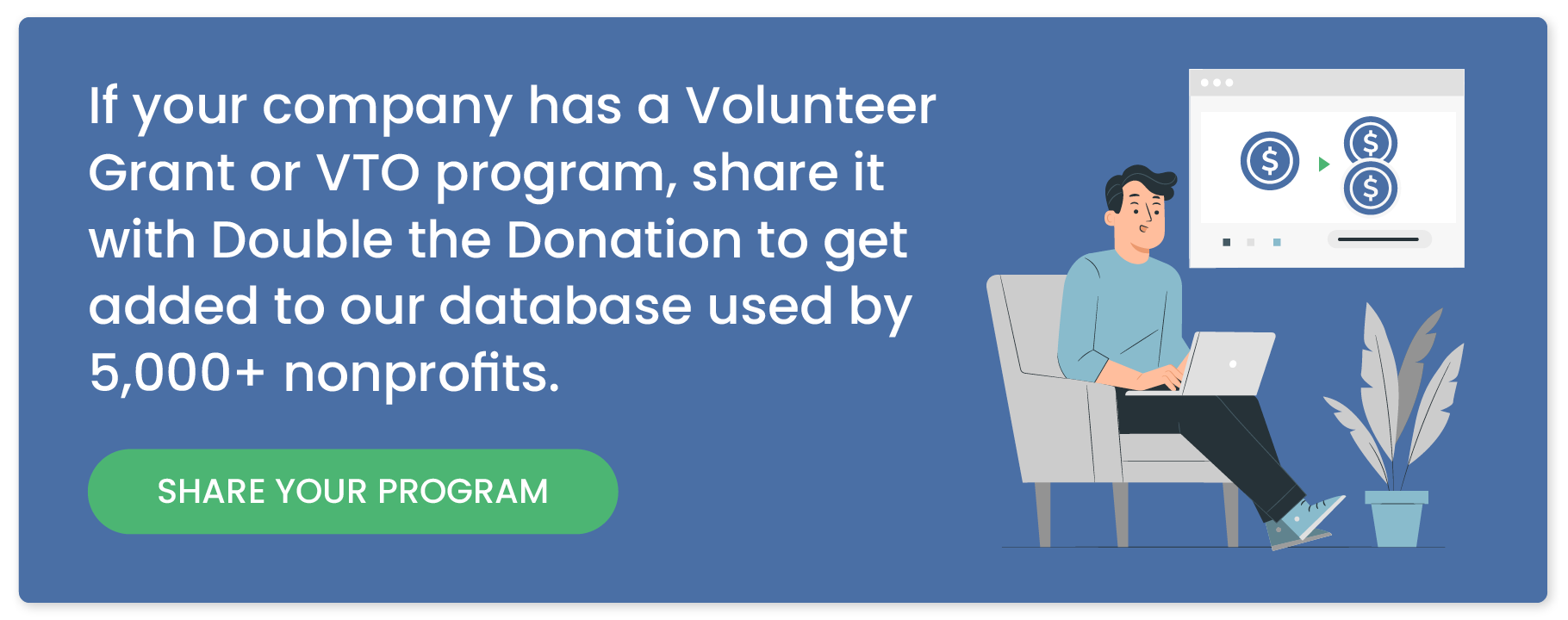Employee Volunteer Incentive Programs: Get Your Team Active
An engaged team is productive and loyal, and one way you can motivate your employees is through volunteer activities. Getting your employees out in your community will help them feel fulfilled and understand your company’s commitment to giving back.
However, while volunteering can increase employee motivation, you might first need to motivate your employees to volunteer! Your staff members have busy schedules, and many of them might not have the time to volunteer or even be aware of your company’s volunteer opportunities.
Fortunately, employee volunteer incentive programs are common, and we’re here to share a few tested strategies. In this guide, we’ll explore:
- Why should companies incentivize employee volunteering?
- Employee Volunteer Incentive #1: Create a volunteer grants program.
- Employee Volunteer Incentive #2: Offer volunteer time off.
- Employee Volunteer Incentive #3: Arrange team volunteer activities.
- Employee Volunteer Incentive #4: Connect employees with nonprofits.
- Employee Volunteer Incentive #5: Recognize employees who volunteer.
- Employee Volunteer Incentive #6: Create a day of service.
- Employee Volunteer Incentive #7: Get leadership involved.
Corporate volunteerism programs are a win for your company, your employees, and nonprofits in your local community. Your company gets an energized and loyal workforce, employees get to take a hands-on approach to giving back, and nonprofits get more help with their programs. With that in mind, let’s look at the research behind why companies should incentivize employee volunteering.
Why should companies incentivize employee volunteering?
A lot of research has been done on the connection between corporate volunteer programs and employee engagement. Nearly every study points to the same key findings: employees want volunteer programs and businesses that offer them have engaged, productive workforces.
Let’s look at a few specific statistics:
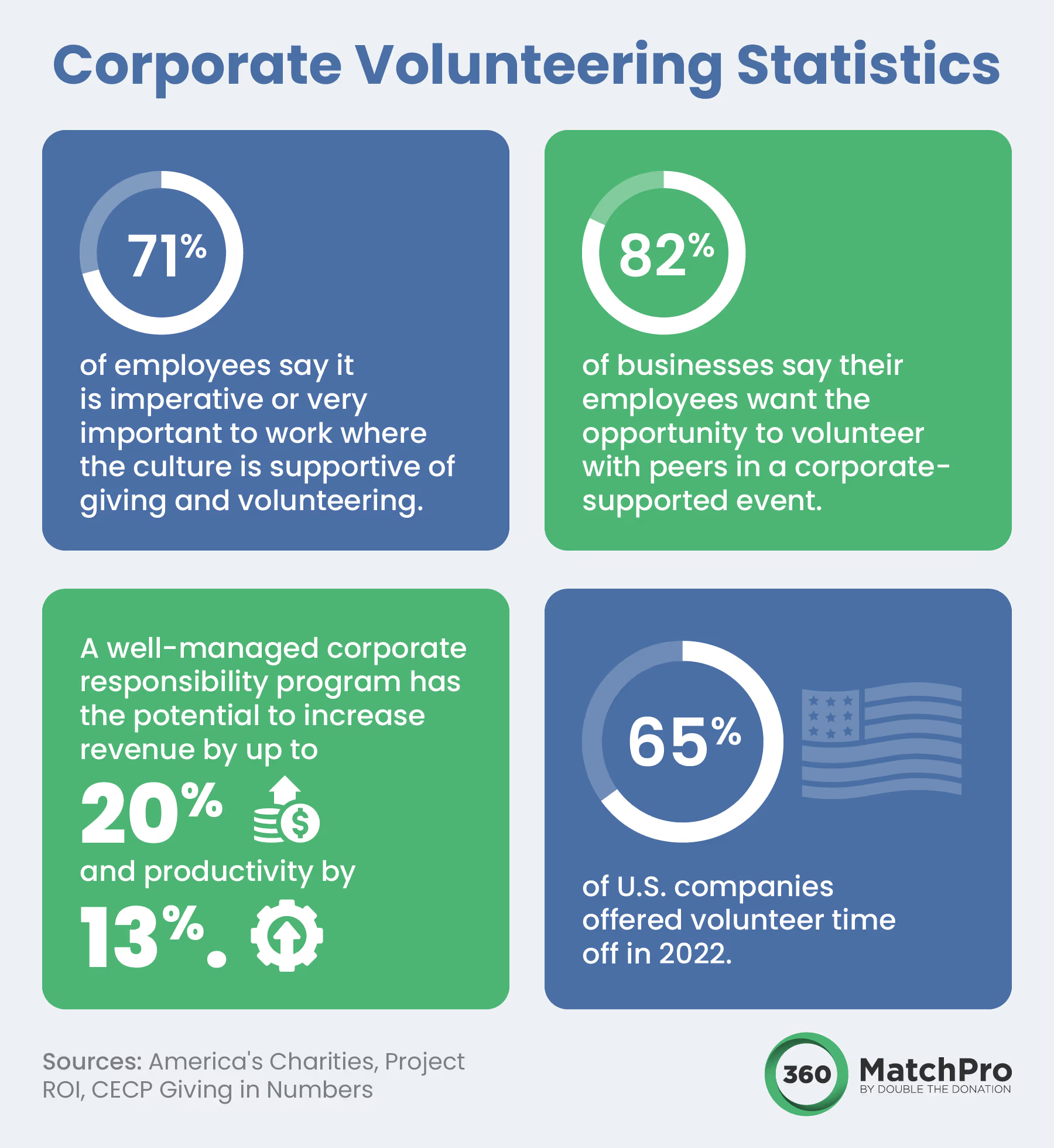
- 71% of employees say it is imperative or very important to work where the culture is supportive of giving and volunteering.
- 82% of businesses say their employees want the opportunity to volunteer with peers in a corporate-supported event.
- A well-managed corporate responsibility program has the potential to increase revenue by up to 20% and productivity by 13%.
- 65% of U.S. companies offered volunteer time off in 2022.
These statistics show that volunteer programs are in demand, widespread, and lead to positive outcomes for employees and businesses alike.
Along with helping employees feel a stronger sense of purpose, employee volunteer programs can also act as team-building activities, helping your staff strengthen communication, their sense of community, and team loyalty. However, volunteer programs are also most effective when you can accommodate as many employees’ interests as possible, which may be challenging to do solely through team opportunities.
To balance these factors, many companies offer a variety of employee volunteer incentives that encourage both individual and team volunteering. Let’s dive into our first program idea.
Employee Volunteer Incentive #1: Create a volunteer grants program.
Incentivize employees to volunteer by donating to the nonprofits they work with. This corporate volunteer incentive program is called volunteer grants, and it motivates employees by making their volunteering more impactful and showing them that their employer supports the same causes they do.
Every company that offers volunteer grants has its own program requirements. For example, most volunteer grant programs follow one of these models:
- Per-hour. Offer to donate to the nonprofits your employees volunteer for depending on how many hours they serve. For example, you might provide nonprofits with $10 for every hour an employee volunteers.
- After reaching an hour threshold. Many corporations provide nonprofits with a flat donation after an employee volunteer reaches a certain number of hours. For example, you might donate $100 after 20 volunteer hours. Some businesses combine this approach with the per-hour system, requiring employees to volunteer certain blocks of time to receive a flat donation. For instance, our list of volunteer grant companies highlights that Allstate Insurance provides employees with $500 for every eight hours volunteered.
- Tier system. Tier systems are more complex and incentivize employees to volunteer more than they might otherwise to hit the next tier. For example, Disney’s “EARS to You” grant has the following volunteer tiers:
- 10-24 hours → $100 grant
- 5-49 hours→ $250 grant
- 50-74 hours → $500 grant
- 75-149 hours → $1,000 grant
- 150+ hours→ $2,000 grant
Additionally, many companies that offer volunteer grant programs also offer matching gift programs. These two types of corporate giving programs share several similarities, such as requiring a contribution from participating employees. For instance, check out The Hershey Company’s matching gift and volunteer grant information:
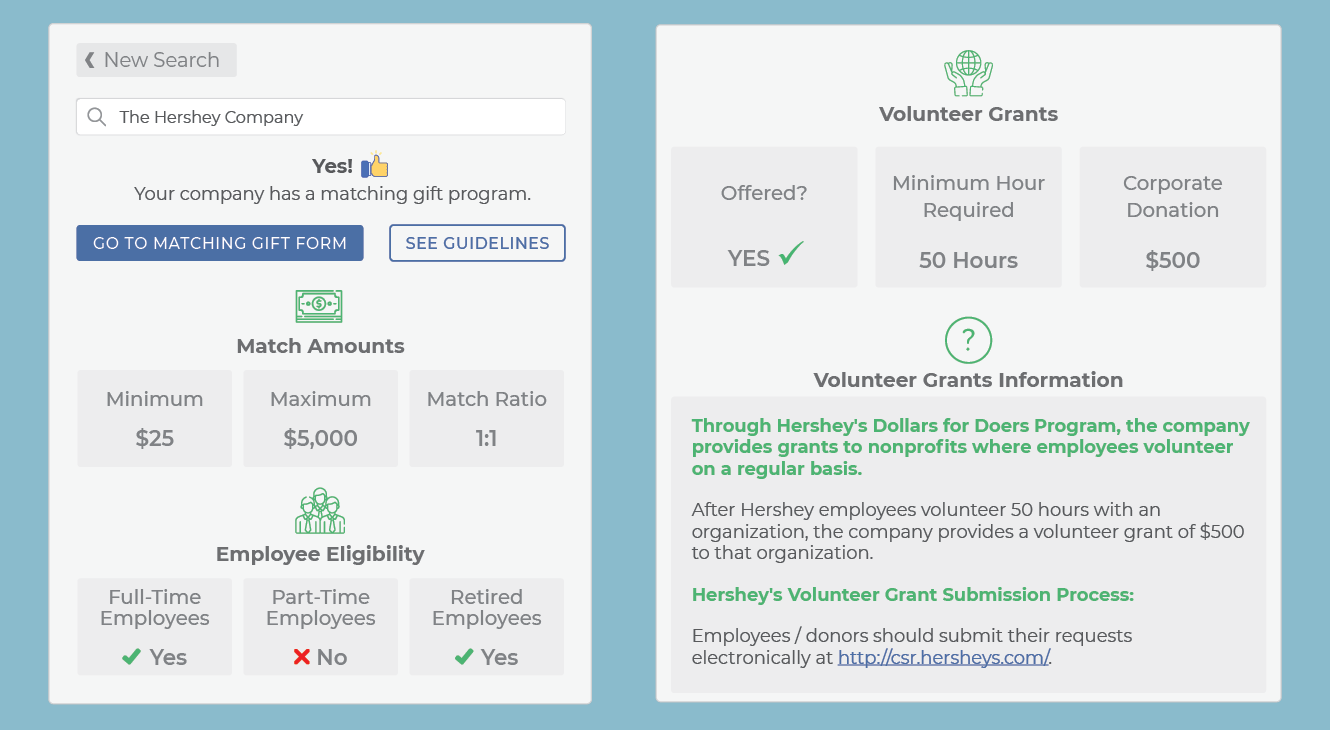
Hershey has relatively straightforward volunteer grant and matching gift programs that demonstrate a few other requirements to consider when launching your own program. These include:
- Employee eligibility. Are all of your employees eligible for volunteer grants and matching gifts? Hershey allows full-time and retired employees to submit matching gift requests but not part-time workers.
- Max donation amounts. How much will your business give per employee per year? Consider your budget, estimated participation rate, and potential tax benefits. Remember that donations made through matching gifts and volunteer grants are tax deductible.
- Types of eligible nonprofits. You can focus employee efforts by making specific types of nonprofits eligible for volunteer grants or matching gifts. However, doing so also limits employee choice and may disincentivize participation. Most commonly, companies make all types of nonprofits, except for religious organizations and political campaigns, eligible.
Last, consider what information you’ll need employees to share when submitting a volunteer grant request form. Usually, volunteer grant applications ask for the number of hours volunteered and basic information about the nonprofit, such as its mission, address, contact details, and EIN.
To confirm applications, you can then contact nonprofits to verify the employees’ hours, the nonprofit’s tax-exempt status, and the types of activities your employees are completing.
Employee Volunteer Incentive #2: Offer volunteer time off.
49% of people state that work commitments are their biggest obstacle to volunteering. This means that nearly half of all people who want to volunteer but can’t are held back by their employers rather than incentivized by them.
You can rectify this trend at your business by offering a volunteer time off (VTO) program. Volunteer time off is like normal paid time off, only employees use these days specifically to volunteer. Along with freeing up employee time for volunteering, VTO programs also allow employees to volunteer during a weekday rather than giving up their nights or weekends.
Before adding VTO to your company benefits, establish a few program guidelines to ensure employees understand how to use VTO. Let’s break down the elements of this example VTO policy:
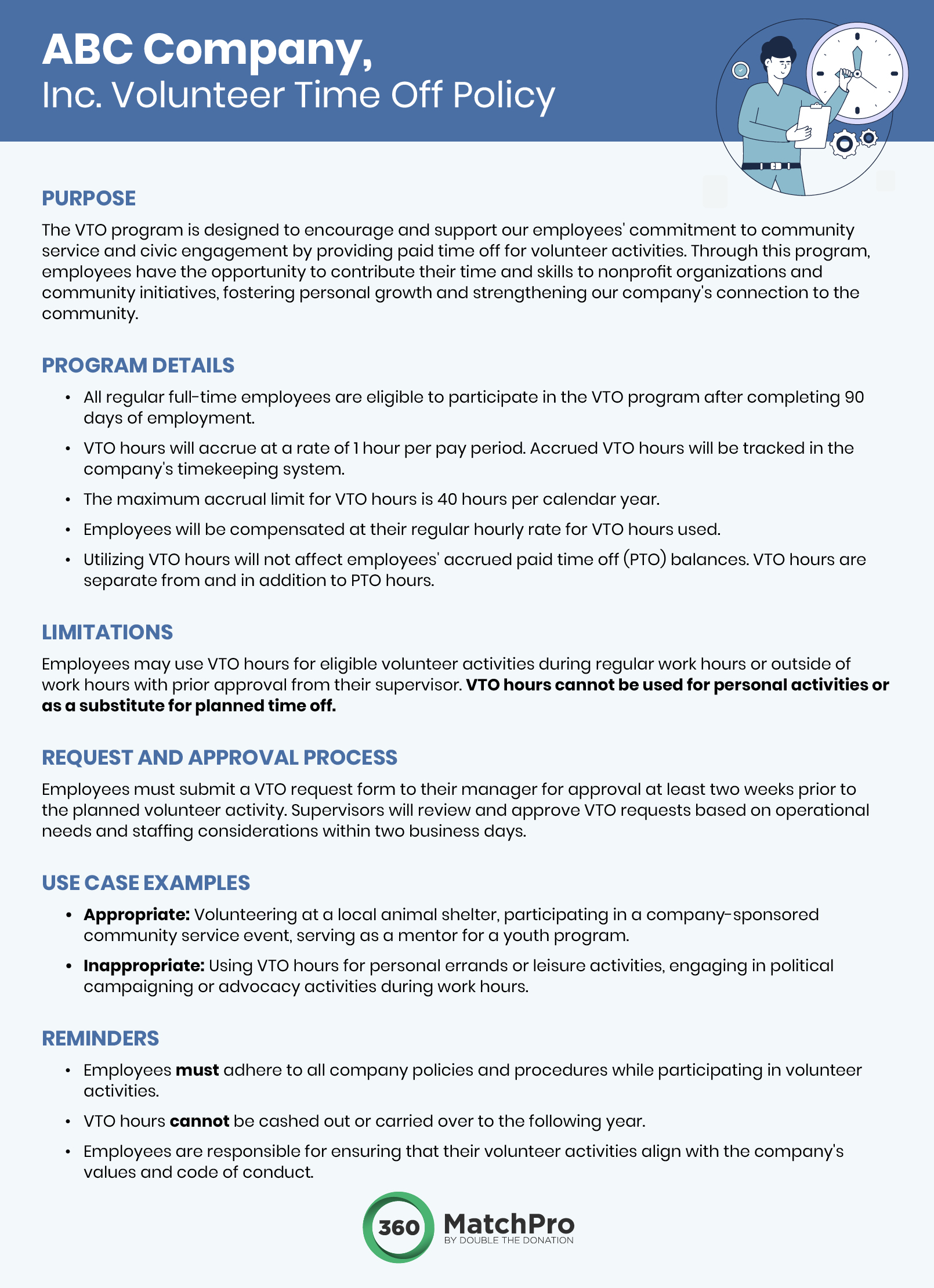
- Purpose. Explaining why your company has decided to offer a VTO program helps set expectations and provides context for your company’s employee engagement efforts.
- Program details. Provide details for what your VTO policy looks like in practice, including how many hours employees have per year, which employees are eligible for the program, and how employees can request VTO.
- Limitations. Clarify what VTO can and cannot be used for, including what types of nonprofits are exempt from VTO.
- Request and approval process. If employees must submit VTO requests a certain amount of time in advance, fill out a request form, or inform specific team members about their planned VTO, include that in your policy. Additionally, be transparent about how and why VTO requests are evaluated.
- Use case examples. To ensure everyone is on the same page about what types of time off requests fall under VTO and what is inappropriate, provide short examples. These might include examples but causes that are not appropriate for VTO or how VTO and regular time off requests can not be used interchangeably.
- Reminders. Clarify any miscellaneous information, such as if VTO hours rollover from year to year or if they can be cashed out if they go unused.
When announcing your program, share your policy with all employees and provide the opportunity to ask questions. Additionally, you can add VTO as a benefit to working for your business, which can be helpful in recruiting talented new employees.
Employee Volunteer Incentive #3: Arrange team volunteer activities.
Encourage teamwork by arranging team volunteer activities. During these events, your entire team will take a few hours or a day off of work to help out at a local nonprofit. To ensure your team volunteer opportunities succeed, be sure to:
- Consider employee interests. What types of causes do your employees want to support? What activities will engage them? You might have employees suggest local organizations to arrange team volunteer activities with or provide a few nonprofits and have employees vote.
- Collect sign-ups. Both your business and the nonprofit you volunteer with will benefit from having a headcount in advance. If your event is not mandatory, ask employees to sign up ahead of your volunteer day.
- Coordinate with nonprofits. Nonprofits appreciate volunteers but many organizations may not know what to do with a large team suddenly showing up. Reach out to the nonprofit your team plans to volunteer with ahead of time. This allows them to plan activities that accommodate a team that wants to work together and identify tasks that fit your employees’ specific skill sets.
Team volunteer activities resolve several obstacles employees often face when volunteering. With your business arranging the volunteer activities, employees won’t need to research and assess volunteer programs or worry about taking time off.
Employee Volunteer Incentive #4: Connect employees with nonprofits.
Many employees don’t volunteer simply because they aren’t aware of local nonprofit volunteer programs. You can incentivize these employees to volunteer by providing information about nonprofits and volunteer programs in your community.
Consider investing in corporate social responsibility (CSR) software that includes volunteer management tools and a nonprofit database. These tools allow you to find and highlight volunteer opportunities for employees, and employees can search the database to find verified organizations with missions that align with their interests.
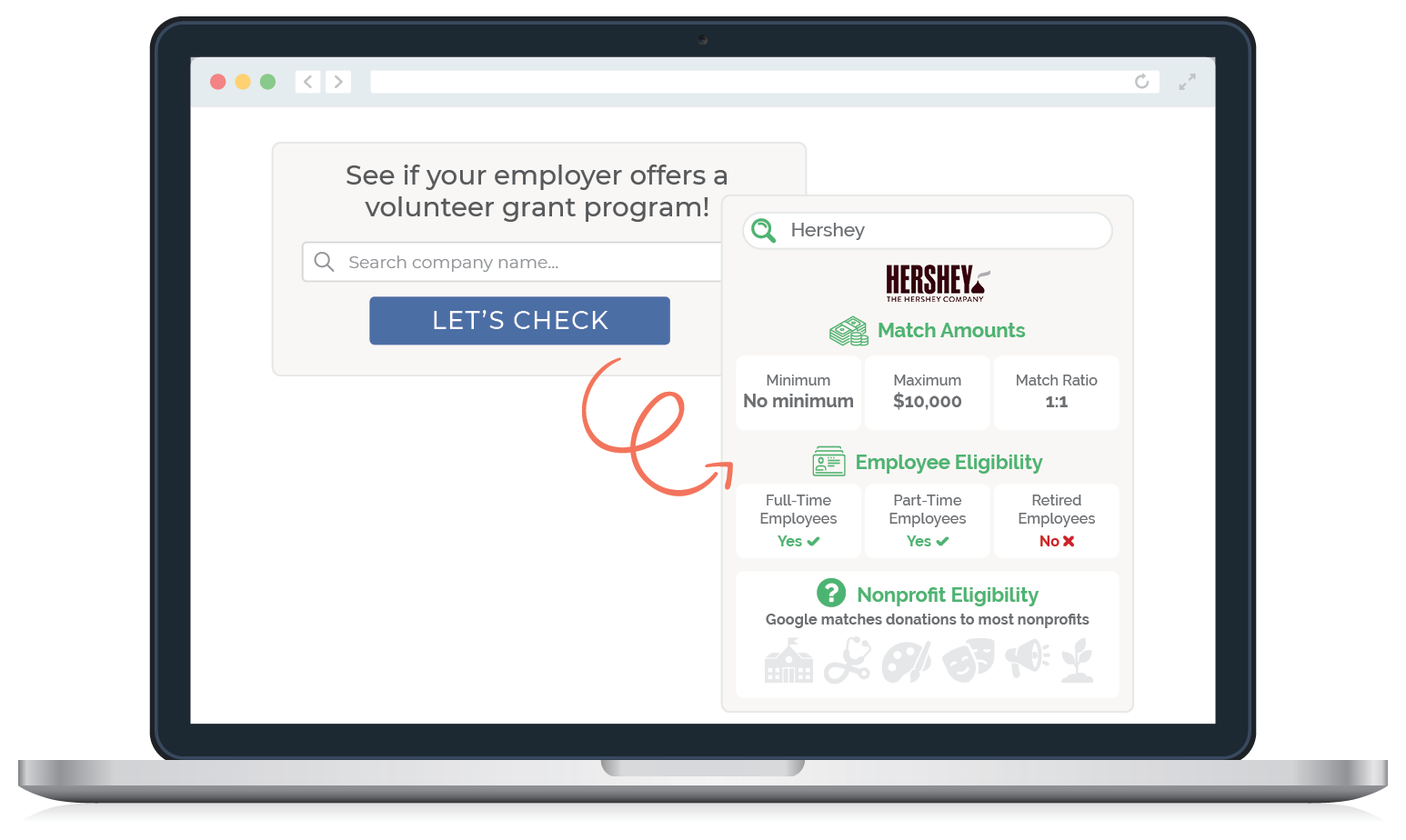
Additionally, make sure your business is featured in databases for nonprofits. For example, many nonprofits use matching gift and volunteer grant software to help supporters discover their eligibility for corporate giving programs. You can search for your company in these databases to ensure your business is featured.
If your business is missing or you launch a new volunteer grant or matching gift program, reach out to the software vendors to provide information about your new initiative. This way if employees volunteer or donate independently, they can discover that your business supports them.
Employee Volunteer Incentive #5: Recognize employees who volunteer.
Incentivize a specific behavior by showing your employees appreciation whenever they do it. This means that when employees volunteer, acknowledge their efforts and recognize their contributions.
A few ways you can show appreciation for your employee volunteers include:
- Awards. Create appreciation awards related to volunteering and hand them out to employees who reach certain volunteering-related milestones or accomplishments. For example, you might create an award for the employee who volunteers the most that year. Plus, by publicly giving out awards, you can incentivize other employees to volunteer as well.
- eCards. Thank individual employees for volunteering with recognition eCards. Create eCards specific to recognizing volunteers and send them out to employees who regularly volunteer. For example, check out this eCard that recognizes an employee for their compassion, connecting volunteering to the company’s values.

- Grants. Similar to volunteer grants, consider creating monetary prizes for the nonprofits where employees volunteer. For example, you might award your top employee volunteer by donating an extra $1,000 to the nonprofit of their choice or providing grant stipends employees can give to any nonprofit of their choice after volunteering a certain number of hours.
Use your CSR software to track employee participation in volunteer opportunities. Then, set parameters for when you’ll give out an appreciation award. For example, you might present appreciation awards at the end of the year to employees who have volunteered for over 100 hours or send a thank-you message to employees after they volunteer for 10 hours.
Employee Volunteer Incentive #6: Create a day of service.
Designate a specific day every year for employees to give back to their community. You might arrange a team volunteer activity on this day or give employees the day off to volunteer independently.
Any day of the year can be your day of service. Consider choosing a date relevant to your company, such as the anniversary of your founding, or choose a date during National Volunteer Week.
A day of service also encourages employees to get creative and give back in their own ways. This is especially helpful for companies with multiple offices or that have a hybrid workplace as employees can volunteer in their respective communities.
Employee Volunteer Incentive #7: Get leadership involved.
When making any change in your company’s culture, leadership getting involved and setting an example goes a long way. Encourage your company’s managers, senior staff, and top decision-makers to volunteer alongside the rest of your team.
To ensure employees see leadership volunteering, consider planning team volunteer activities that include senior leaders. This way your staff will get the experience of working with leadership directly while volunteering, fostering the sense that your entire business is committed to social good.
More Corporate Volunteering Resources
Employee volunteer incentive programs give your team the motivation they need to get out in their communities and lend a helping hand. As a result, your company will have a more engaged, satisfied, and loyal team.
For more information related to corporate volunteering and employee engagement, explore these resources:
- 23+ Corporate Volunteer Ideas to Build A Better Community. Need ideas for volunteer activities your employees can do? Get inspired with these corporate volunteer ideas.
- Corporate Volunteerism: A Guide for Purpose-Driven Companies. For a deeper dive into corporate volunteerism, check out this complete guide.
- Winning Workplace Giving Strategies & How to Leverage Them. Workplace giving is another way to engage employees. Discover winning strategies for employee giving.



